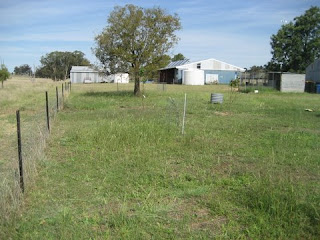Of late we’ve had quite a bit of rain resulting in rapid growth of the grass in the house yard. One of our mobs of sheep was in the front paddock as part of our grazing plan. Given that the weather is quite hot at the moment we decided to let the mob of over 400 sheep into the house yard to eat down the grass a bit and to do a tad of natural fertilization.
Here you can see some of the mob in the northern section of the yard.
This photo shows some of the sheep in the eastern part of the yard.
Yes, they did stir up a little bit of dust in the process but this was not an issue at all. See below.
To prepare for the sheep coming into the yard we moved some potted plants up out of the reach of the sheep and covered with mesh guards those we definitely did not want eaten.
It was difficult to assess how long the sheep should stay in the yard before bringing them in. To be safe we decided to 'stand guard' and let them out when we felt they'd taken enough of the herbage mass. The total duration ended up being approximately half an hour.
One unforeseen bonus of the sheep being in the yard was that they did an excellent job 'trimming the edges' and eating under things in the yard (like the trampoline) that we'd normally need to move if using the mower.
Here's a range of 'before' and 'after' photos. Not a bad effort, we think, especially given the whole process took less time than conventional mowing ... and a lot less energy.
Location 1 - Before
Location 1 - After
The hose is more visible and the flowers of the Patterson's Curse plants have been eaten.
Location 2 - Before
Location 2 - After
Location 3 - Before
Location 3 - After
Location 4 - Before
Location 4 - After
(Sorry ... this photo from a comparison perspective is a bit tough to judge ... it was taken on dusk).
We learned during the process that in addition to grass the sheep loved eating the following plants in the house yard:
- Peach and apricot trees
- Lilac tree
- Grape vine
On the other hand none of the sheep touched any of the following plants in the house yard:
- Geraniums
- Heliotrope
- Pumpkin
- Cassinia
- Nodding Blue Lilly
- Lemon Tree
- Smoke bush
We thought it was pretty neat that (as you will see in the following photograph) the sheep ate the weeds around one of the potted geraniums but left the geranium alone.
Given the success of the exercise we think we'll do a repeat each time we have a largish mob of sheep in the Front Paddock.












